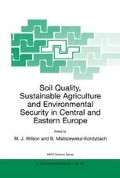Abstract
For many centuries, agriculture in Ukraine has been associated with decreasing soil fertility. Effectively, crops were grown at the expense of losses in potential soil fertility leading also to the degradation of soil physical properties of agricultural importance. Nutrient losses were partly compensated for by the application of organic and mineral fertilizers so that a gradual decline has occurred in soil nutrient status. As a result the biological cycling of many elements in the soil has been disrupted, leading to ecological changes on a landscape scale, enhanced wind and water erosion and ultimately to even greater losses in soil fertility [4,5].
Access this chapter
Tax calculation will be finalised at checkout
Purchases are for personal use only
Preview
Unable to display preview. Download preview PDF.
References
Shykula M.K.(1997). Biochemical mechanism for soil fertility self-regulation. — Scientific proceedings of Nat. Agric. Univ. — 1, 163–171.
Shykula M.K., Melnychuk D.O. et al. (1995) Heterotrophic fixation of carbon dioxide and it role in chemozem’s soil organic matter formation. Proceedings of agricultural science-8, 23–28.
Shykula M.K., Ridei N.M. et al. (1996) Intensity of carbon dioxide assimilation by varios soil units of Ukraine. Proceedings of agricultural science - 8, 15–19.
Shykula M.K., Nazarenko G.V.(1990) Minimum tillage of Chernozems and Reproduction of their fertility, Moscow, Agropromizdat.
Shykula M.K., Antonets C.C., Kapshtyk M.V.(1998) et al. Soil fertility Reproduction in Conservation Farming, Kyiv, Oranta.
Author information
Authors and Affiliations
Editor information
Editors and Affiliations
Rights and permissions
Copyright information
© 2000 Springer Science+Business Media Dordrecht
About this chapter
Cite this chapter
Shikula, M.K. (2000). A Mechanism for the Self-Regulation of Fertility in Ukrainian Chernozems. In: Wilson, M.J., Maliszewska-Kordybach, B. (eds) Soil Quality, Sustainable Agriculture and Environmental Security in Central and Eastern Europe. NATO Science Series, vol 69. Springer, Dordrecht. https://doi.org/10.1007/978-94-011-4181-9_20
Download citation
DOI: https://doi.org/10.1007/978-94-011-4181-9_20
Publisher Name: Springer, Dordrecht
Print ISBN: 978-0-7923-6378-1
Online ISBN: 978-94-011-4181-9
eBook Packages: Springer Book Archive

